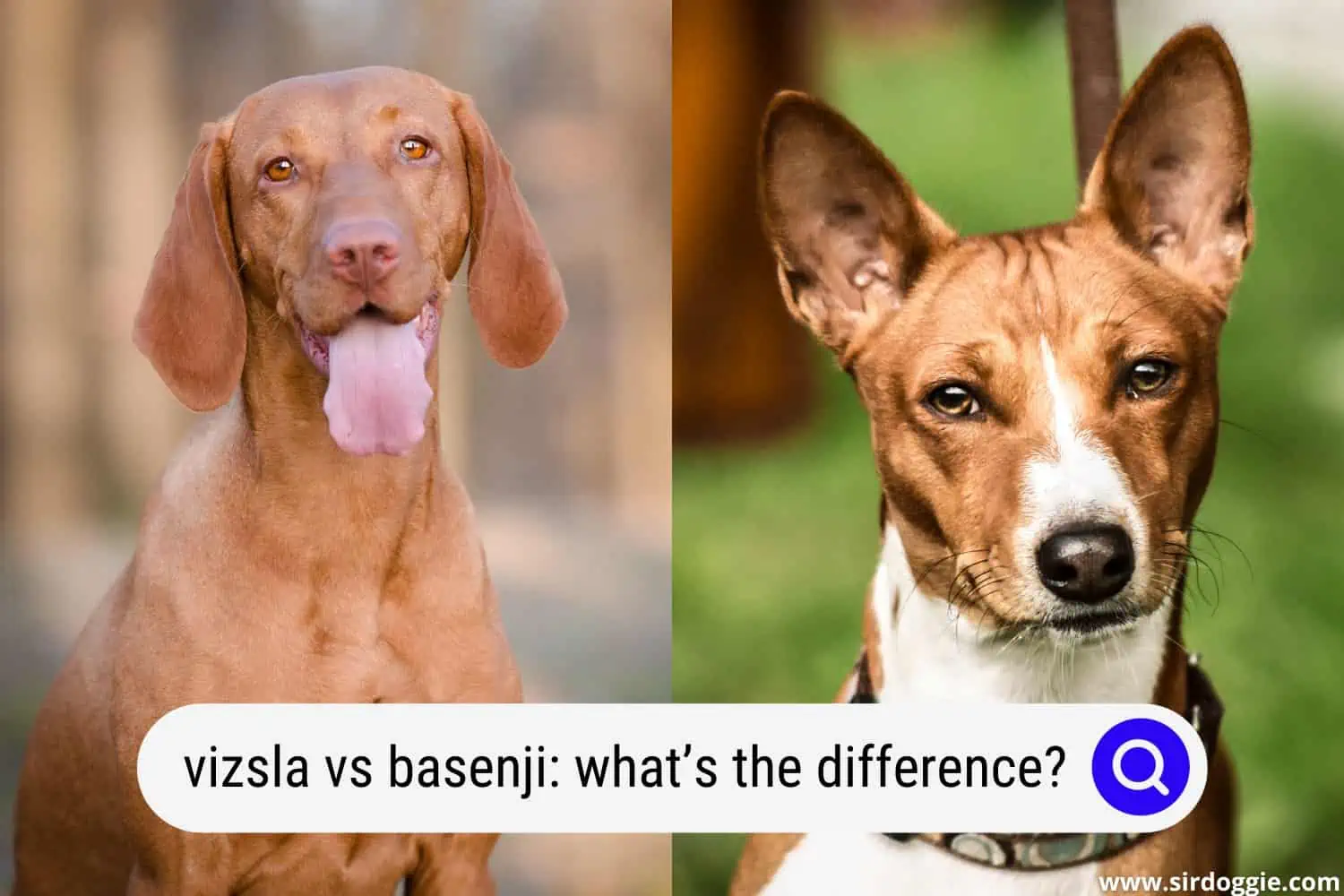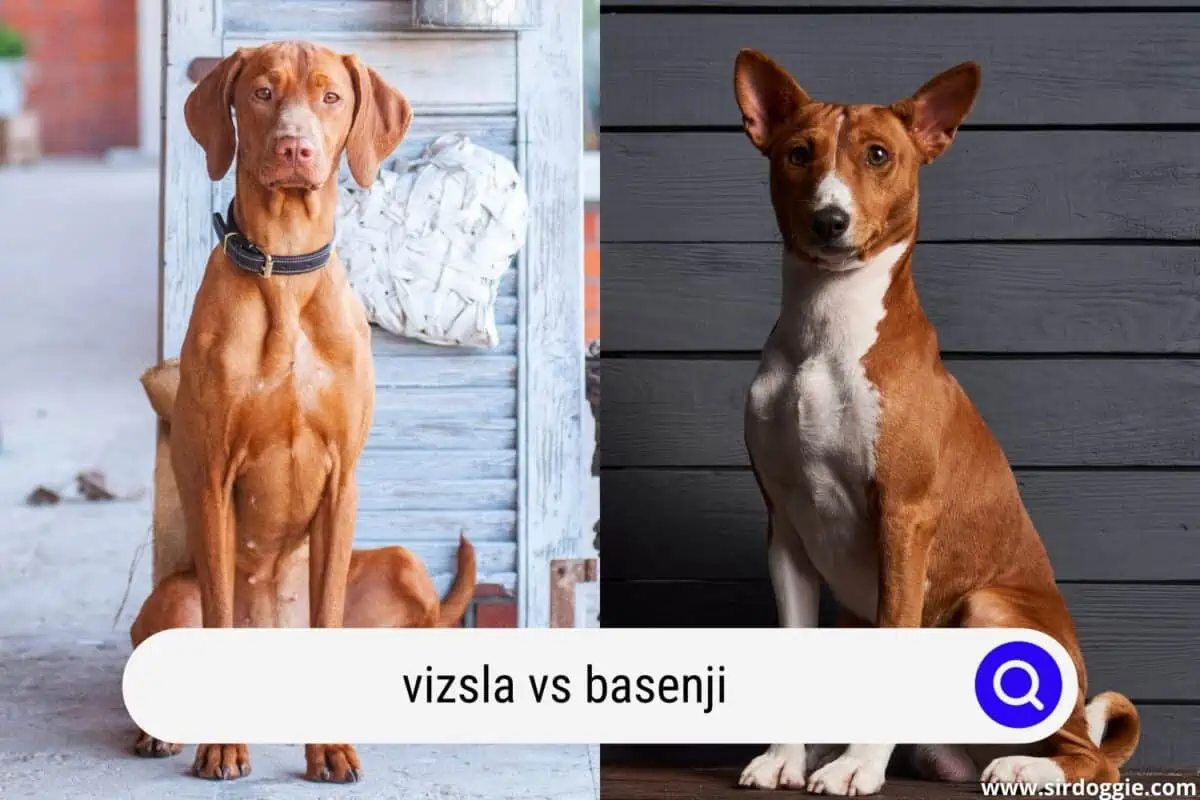Vizsla vs Basenji: What’s the Difference?
One is from Europe and the other is from Central Africa; but how do the Vizsla and Basenji differ and how similar are they? These are no doubt two beautiful-looking dogs that are used for hunting.
How intelligent are they? What are their unique character and characteristics that can make you choose one over the other? In this Vizsla vs Basenji comparison article, we will give you detailed information on the two breeds and then make a head-to-head comparison.

The Vizsla: The strong and athletic Hungarian Pointer
Known as the Vizsla in its native Hungary, the Hungarian Pointer is one of the oldest breeds in Europe. They were bred to hunt in tandem with falcons. But today they prefer to be on the lookout for the best spot on the couch.
They are versatile, athletic, good therapy dogs, and reliable guardians. Is it the right dog for you? Find out below.
Origin and History of the Hungarian Pointer
Like many European breeds, their lineage is so old that no records are kept. They are believed to be descended from dogs such as the Pannonian Hound, the Weimaraner, and the German Shorthaired Pointer.
The earliest Vizsla was similar to a bloodhound, with longer legs and ears, as well as a well-developed snout. In the 20th century, breeders achieved more elegant-looking specimens, with the introduction of breeds such as the German Pointer or the Pointer.
Originally used by the Hungarian nobility, they are strong and light dogs, capable of traveling long distances. With the appearance of the rifle, its hunting technique changed, focusing on the detection and marking of the prey and their retrieval.
After the two world wars that ravaged the continent, they were on the verge of disappearing, but the effort of variety lovers made them resurface in the mid-1960s.
Physical characteristics of the Vizsla
The Vizslas have an athletic body and balanced proportions, being slightly longer than they are tall. Its neck is well developed, with a straight muscular back. The chest is deep and not very wide.
The legs, with strong bones, are straight and with muscular shoulders. The hind limbs have low hocks and powerful thighs. The tail is also set low, thick at the beginning, and tapering towards the tip.
The head, of noble bearing, is in proportion to the rest of the body. The muzzle is rather short and has a straight shaft. The eyes are oval, with colors to match the coat. The ears are wide and thin-skinned, in a rounded V shape.
Finally, the coat is well attached to the body in its entirety. It is very dense, short, and straight. Its texture is rough. The colors are dark yellow or fawn in all its shades. Small white patches on chest and foot areas are commonly found.
The character of the Vizsla
Bred to hunt side by side with man, the Vizsla maintains that need for human companionship. These dogs are always looking for someone to hang out with and will follow you wherever you go. The best gift you can give them is a caress.
Due to their restless nature and great energy, they are not recommended for children under 6 years of age. They will get along well with other dogs in the household and also with cats if they have been raised together. Domestic birds are another story, as they will always see them as prey. It is also not a good idea for them to live with small animals, such as rabbits or hamsters.
On the other hand, they are great talkers. They tend to moan and make other noises to give their opinion. Unlike the Basenjis, they also bark a lot. If you don’t control this habit from a young age, it will be much more difficult to eradicate as an adult.
They also like to chew and nibble on everything in their path, so be sure to get them suitable toys to leave your most valuable items alone.
A Hungarian Pointer can be somewhat introverted with strangers, so early socialization is necessary. That way, it won’t develop sullen habits or become so shy. Because of their bravery and loyalty to their people, they are usually good watchdogs. In certain cases, they can also make excellent therapy dogs.
They are dogs that learn easily, which added to their innate need to please makes them easy to train. However, Vizsla tends to be curious and easily distracted. To keep them focused, offer them constant challenges that are not repetitive.
Main health problems of the Vizsla
Epilepsy and hypothyroidism are some of the most common diseases of the Vizsla. Other common conditions in the breed are hip dysplasia and progressive retinal atrophy.
Lymphosarcoma is a type of cancer that usually affects Vizsla moderately. This disease usually attacks the skin, kidneys, and nervous system of the dog. It is often hereditary in origin and is usually treated with chemotherapy.
Basenji: the only dog that doesn’t bark
These small dogs stand out for their hunting instinct and their excellent tracking skills. The Basenji come from Western-Central Africa (specifically, Zaire in Congo), where they are still used today for hunting small animals.
They require little maintenance and are easy to train due to their curious disposition and intelligence. In the following paragraphs, we will delve into the peculiarities of the Basenji, or the so-called Belgian Congo dog.
Basenji breed origin and history
Basenji are known to be very ancient dogs. In Ancient Egypt, there were reliefs that represented these dogs together with greyhounds and hounds.
It is believed that they traced their lineage from the outcasts to the Egyptians and from these to the tribes of the Congo, where they have been used to hunt in packs. To have them located in the deep jungle, they placed cowbells.
Its name means ‘bush dog’ and is attributed to Mrs. Burn, of British origin, in 1936. In the late 1800s, they were introduced to Europe, but distemper wreaked havoc and no Basenji survived.
In the 1930s, they were imported to England and in 1941 to the United States, where they were genetically modified to include the brindle pattern. The first registration dates from 1944 in the American Kennel Club, which recognized them as a breed years later, in 1948.
Basenji characteristics
They tend to have their heads erect, something that together with their long legs, their short back, and their curly tail gives their body a square appearance. Its head is triangular and it has wrinkles on its forehead. Its muzzle is moderately wide, its ears are large, triangular, and erect, and its eyes are almond-shaped and dark.
Character: How does a Basenji behave?
Basenjis are noble, curious, and very independent dogs. Used for hunting and tracking because of their excellent sight and smell, they are used to living in packs. However, when it comes to animals of other species, they are dominant and do not tolerate provocations.
Therefore, socialization is essential if they are going to live with other animals. They are also not an ideal breed if you have small children at home, as they could attack them. They are not very attached to their family, but that does not mean they do not regularly demand attention. They are very protective of those they consider to be in their community.
They love to climb and do not bark. Instead of barking, this breed emits a particular sound, a mixture of Tyrolean songs and a stifled laugh. They do not like to be alone and inactive for a long time. If they get bored, they don’t hesitate to do their thing and destroy everything in their path.
Caring for the Basenji dog
In addition to the daily activity divided into 2 or 3 walks of about 40-45 minutes, these dogs do not require much more care. They hardly lose hair, so it will be enough to brush it or wipe it a couple of times a week.
Their food must be varied and of quality. Keeping its vaccination and deworming calendar up to date will help keep it healthy and happy.
Vizsla vs Basenji: Comparison Table
| Vizsla | Basenji | |
| Size | between 58 and 64 cm in height in males and between 54 and 60 cm in females | Height of over 43 cm in males and over 40 cm in females |
| Weight | between 20 and 30 kg for males and between 18 and 25 kg for females | between 11 and 13 kg in males and between 8 and 10 kg in females |
| Life expectancy | 12 to 14 years | between 12 and 14 years |
| Ideal for | living in houses with gardens; families with children over 6 years old; therapy dogs; performing guard duty. | hunting small games They can also they can be great companions for older children. |
| Health challenges | prone to hip dysplasia | prone to kidney problems and digestive pathologies |

Conclusion
The two dogs are very similar in physical attributes. Both have short and very soft hair. The predominant colors in a Basenji are black, reddish, brown, and brindle with a white chest, legs, and tip of the tail.
They are independent, active, and have a protective character. It will give its life to defend its family, if necessary, but it is not very fond of caresses, unlike the Vizsla. It is advisable to socialize him from an early age to subdue his hunting instinct if he is going to live with other pets
Meanwhile, the Vizslas can live with families with children. Their main colors are golden rust, golden, and red golden. While the Vizslas bark a lot, the Basenjis don’t bark.

Family Dog Expert Author
Hi there! I’m Stuart, a devoted dog lover and family dog expert with over a decade of experience working with our furry companions. My passion for dogs drives me to share my knowledge and expertise, helping families build strong, loving bonds with their four-legged friends. When I’m not writing for SirDoggie, you’ll find me hiking, playing with my beautiful dog, or studying music.